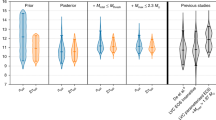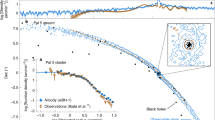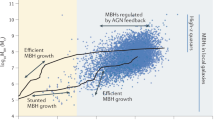Abstract
In an open Universe, or even in just a long-lived Universe (as predicted in inflationary Universe models1–3), the ultimate demise of matter is a certainty. Stars, of course, have only a fleeting existence as they must eventually exhaust their nuclear fuels (in ∼1010 yr for a 1 M⊙ star). In 1014 yr or so new star formation will have ceased, and only neutron stars, white dwarfs, planetary-sized objects (such as Jupiter and Earth) and black holes will remain4. In the simplest grand unified theories (GUTs) the proton lifetime is but 0(1030 yr), so that after this time neutron stars, white dwarfs, and planets will cease to exist. (Due to gravitational effects alone the proton lifetime is expected to be 0(1046 yr) or less.) Although they could outlive the other three, black holes will also eventually disappear, evaporating through the Hawking process5 in a time ≃1064(M/M⊙)3 yr. I point out here that the existence of just a tiny flux of superheavy magnetic monopoles, say F≃F−21 × 10−21 cm−2 sr−1 s−1, will, due to monopole-catalysed nucleon decay6,7, hasten the demise of matter. Due to the monopoles that collect inside them, the lifetime of a neutron star will be ≃1011F−½−21 yr, of a white dwarf ≃1014F−½−21 yr, and of an Earth-like planet ≃1018F−½−21 yr.
This is a preview of subscription content, access via your institution
Access options
Subscribe to this journal
Receive 51 print issues and online access
$199.00 per year
only $3.90 per issue
Buy this article
- Purchase on Springer Link
- Instant access to full article PDF
Prices may be subject to local taxes which are calculated during checkout
Similar content being viewed by others
References
Guth, A. Phys. Rev. D23, 347 (1981).
Linde, A. Phys. Lett. 108B, 389 (1982).
Albrecht, A. & Steinhardt, P. Phys. Rev. Lett. 48, 1220 (1982).
Dyson, F. Rev. mod. Phys. 51, 447 (1979).
Hawking, S. W. Nature 248, 30 (1974).
Callan, C. G. Phys. Rev. D25, 2141 (1982); D26, 2058 (1982).
Rubakov, V. A. Pis'ma Zh. eksp. tear. Fiz. 33, 658 (1981) [J. exp. theor. Phys. Lett. 33, 644 (1981)]. Nucl. Phys. B203, 311 (1982).
't Hooft, G. Nucl Phys. B79, 276 (1974).
Polyakov, A. M. Pis'ma Zh. eksp. teor. Fiz. 20, 430 (1974) [J. exp. theor. Phys. Lett. 20, 194 (1974)].
Dirac, P. A. M. Proc. phys. Soc. Land. A133, 60 (1931).
Wilczek, F. Phys. Rev. Lett. 48, 1146 (1982).
Preskill, J. Phys. Rev. Lett. 43, 1365 (1979).
Zel'dovich, Ya. B. & Khlopov, M. Yu. Phys. Lett. 79B, 239 (1978).
Turner, M. S. Phys. Lett. 115B, 95 (1982).
Cabrera, B. Phys. Rev. Lett. 48, 1378 (1982).
Parker, E. N. Astrophys. J. 160, 383 (1970).
Turner, M. S., Parker, E. N. & Bogdan, T. Phys. Rev. D26, 1296 (1982).
Ellis, J., Nanopoulos, D. V. & Olive, K. A. Phys. Lett. 116B, 127 (1982).
Ahlen, S. P. in Magnetic Monopoles (eds Carrigan, R. A. & Trower, W. P.) (Plenum, New York, 1983).
Turner, M. S. Nature 302, 804 (1983).
Kolb, E. W., Colgate, S. A. & Harvey, J. Phys. Rev. Lett. 49, 1373 (1982).
Dimopoulos, S., Preskill, J. & Wilczek, F. Phys. Lett. 119B, 320 (1982).
Bais, F. A., Ellis, J., Nanopoulos, D. V. & Olive, K. A. Nucl. Phys. B 219, 189–219 (1983).
Freese, K. T., Turner, M. S. & Schramm, D. N. Monopole Catalysis of Nucleon Decay in Old Pulsars, Preprint (University of Chicago, 1983).
Page, D. N. Phys. Lett. 91 A, 201 (1982).
Author information
Authors and Affiliations
Rights and permissions
About this article
Cite this article
Turner, M. The end may be hastened by magnetic monopoles. Nature 306, 161–162 (1983). https://doi.org/10.1038/306161a0
Received:
Accepted:
Issue Date:
DOI: https://doi.org/10.1038/306161a0
This article is cited by
-
A model for cell type-specific differential gene expression during heterocyst development and the constitution of aerobic nitrogen fixation ability inAnabaena sp. strain PCC 7120
Journal of Biosciences (1996)
-
The glutamine synthetase gene family of Arabidopsis thaliana light-regulation and differential expression in leaves, roots and seeds
Molecular and General Genetics MGG (1991)
Comments
By submitting a comment you agree to abide by our Terms and Community Guidelines. If you find something abusive or that does not comply with our terms or guidelines please flag it as inappropriate.



